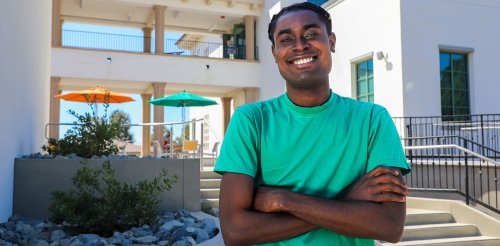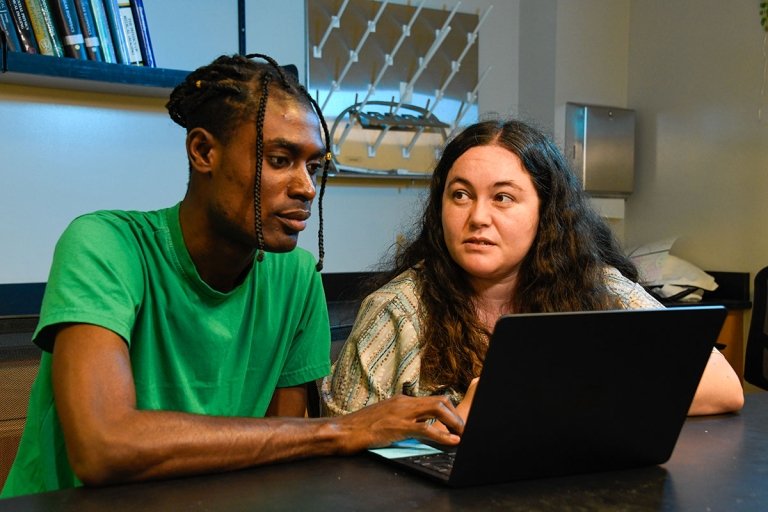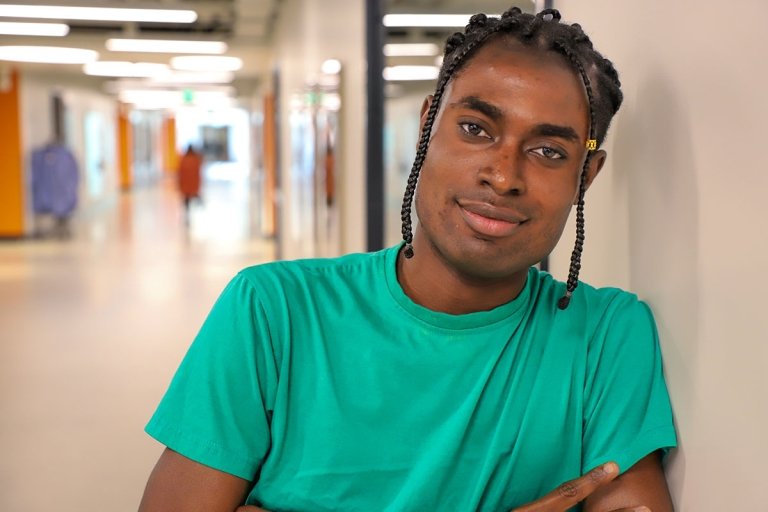Codes of Life
Richard Ampah ’25 looks at cerebral palsy through biology, algorithms, and artificial intelligence

By Bridgette Ramirez
Could computer codes unlock the secrets of the human brain? Richard Ampah ’25 believes so. He is delving into machine learning and developing algorithms to help people with cerebral palsy improve the connection between their brains and bodies.
“I combine the biology with the data, the creation of algorithms, and computational models,” said Ampah, who is a human biology major and mathematics minor.
Cerebral palsy may result from brain damage during pregnancy, childbirth, or early childhood. It disrupts communication between the brain and body, affecting motor skills and muscle coordination. The disability manifests differently from person to person. Someone may walk with assistance while someone else uses a wheelchair. People can also experience issues with sensory perceptions, verbal communication, chronic pain, seizures, and more.
Humans as Algorithms
According to Ampah, computers can take humans’ complex biological systems and simplify them into code and data that is easier to understand. This advantage is vital to studying cerebral palsy since it has many diverse forms. Ampah is using computational neuroscience to create foundational knowledge that will help scientists in the future. He is researching how cerebral palsy works on the biomolecular level, which is difficult to do with a real human brain.
“The human brain is a vulnerable and crucial part of the body,” said Ampah. “You don’t want to go poking at it. It is critical to learn from the outside using an algorithm and applying a human perspective.”
Ampah seeks to recreate human brain behavior and neurons in the forms of computer codes and algorithms. Then, after adjusting the algorithms to make machines more efficient at learning, he hopes to use these algorithms to make the human brain of someone with cerebral palsy more efficient at sending signals to the body.
Ampah considers algorithms as the key to all forms of life—including humans.
“Humans are algorithms because we’re made of bio-molecules and data sequences,” said Ampah. “Even amino acids are algorithms. You sequence them one by one, making sure that you are getting the right ones for things to work the way you want.”
Research That’s Personal

When Ampah was first pursuing his research topic, he made his proposal to various professors only to find their labs already full. Undeterred, he connected with Assistant Professor of Physics Sarah Marzen.
“She was hesitant because I hadn’t done upper division math classes yet, but I was persistent,” said Ampah.
The stakes were personal: Ampah has two young cousins with cerebral palsy. The disability does not prevent people from living their lives provided they receive the accommodations needed to succeed. However, Ampah hoped to help his cousins—and others like them—to navigate their bodies and the world more easily. Ampah thought that machine learning could provide the answer.
Marzen’s lab uses machine learning to understand biological data and interpret biological organisms as machine learners. People and machines both operate using codes and mathematical sequences (albeit in different forms). Thus, Marzen and her students see machines as an ideal tool to better comprehend the biological systems and processes of humans and other living beings.
Marzen acknowledged that studying humans as machines can be philosophically controversial and that the comparison is not a 1:1 ratio. She sees people as machines that use their limited resources as rationally as possible.
“Unlike ChatGPT, we are limited to our brain for information processing and do not have a huge data center that sucks up energy,” said Marzen.
Marzen said that machine learning can use biological data to illustrate the structures behind biological systems. She believes that Ampah’s interpretation of humans as machines “gives us insight, if properly used, into how humans and other organisms work.”
Machine Learning, Equations, and the Human Brain
Ampah became the first student in Marzen’s lab to use machine learning to study cerebral palsy. During his first summer of research, Ampah taught himself linear algebra, Python code, and ChatGPT. He centered his work on reinforcement learning, a field of machine learning that involves adapting behavior to maximize rewards.
“The rewards could be money, better grades, being able to walk,” said Ampah. “It could simply be the freedom to do the things you were not able to do before.”
According to Ampah, reinforcement learning aims to make better decisions at the end of each action. He used a transportation analogy to illustrate his point.
“Say you’re driving to Irvine, and you have to use one of two routes,” he said. “You’re going to choose the one with less traffic. You’re choosing a route with more rewards. That’s a form of reinforcement learning.”
The book Reinforcement Learning: An Introduction states that out of all forms of machine learning, “reinforcement learning is the closest to the kind of learning that humans and other animals do, and many of the core algorithms of reinforcement learning were originally inspired by biological learning systems.”
According to Marzen, Ampah’s research has two impacts. One is that he is Marzen’s first student to use ChatGPT to assist his research (a topic he plans to present to the American Physical Society this spring). The second impact, said Marzen, is evaluating “how well a model of a human with cerebral palsy performs at arbitrary tasks in various environments.
“The hope is that this rigorous quantitative evaluation will then lead to an understanding of how to improve the condition of cerebral palsy,” said Marzen.

"As a science student, you should be able to connect to society. Science, technology, and society go together. Connecting that technical side with the social aspect will make it more realistic for you.”
—Richard Ampah ’25
When Ampah mentioned his research to a friend who worked with kids with cerebral palsy, his friend told him about one child who excelled in swimming but couldn’t walk outside of the water. Ampah was interested in understanding how the psychology and physiology of the brain along with the environment of the water impact movement.
“Swimming is a reward,” said Ampah. “How do we make that a constant thing where that child becomes an expert in it and uses it to translate out of the water?”
Ampah started developing simulated environments where a machine agent stands in for a person with and without cerebral palsy. After two summers of research, Ampah discovered that the reinforcement learning algorithm could potentially help restore the brain’s communication with the body for a person with cerebral palsy. What this will look like in the real world is still far down the line, but Ampah is excited about the possibilities.
Ampah also proved new equations that strengthened the reinforcement learning algorithm. He used the Bellman equation, which solves smaller subproblems to then solve a full problem in the most optimal way, as a baseline. Ampah’s results showed that this baseline can enable the algorithm to find an optimal policy that improves the constraints of people with cerebral palsy. Essentially, the algorithm has the potential to strengthen the brain/body relationship.
“What we did was to make that equation better by proving a different one,” said Ampah. “I could own the equations, and people could cite my equations in future research.”
Interdisciplinary, Community-Oriented Science Learning
Ampah’s interdisciplinary coursework has prepared him well for his research. Pitzer’s human biology major teaches students how to use the tools of biology and the social sciences to explore complex questions about humanity. His mathematics minor has also played a large role in Ampah’s work.
“The brain has a surface topography,” said Ampah. “If a certain portion of the brain isn’t working a certain way, why not use linear algebra and calculus to expand the surface and make it bigger to see clearly the affected part or area of the brain, like whether it is an injury or something else?”
For Ampah, what makes science at Pitzer stand apart is the interdisciplinary emphasis and connection to social issues. He is on the cross-cultural health and healing track for the human biology major, which incorporates biology, chemistry, social sciences, and internships. Knowing the social aspect and science aspect are both crucial to him.
“Knowledge is power,” said Ampah. “I want to learn so much from so many field groups. I can learn about the science of cerebral palsy, but I can also learn about the social behavior.”
Ampah experienced this combination during Professor Alicia Bonaparte’s Sociology of Health and Medicine course. Since it was a social responsibility praxis class, students did an internship to put their learning into practice. Ampah was assigned to AbilityFirst.
According to AbilityFirst’s website, the nonprofit “provides a variety of programs designed to help people with disabilities achieve their personal best throughout their lives.”
Ampah worked with and observed children with disabilities, including cerebral palsy. He saw firsthand how they maneuvered their bodies, their emotions, and their environment. His internship helped him combine the social with the medical and computational sides of his research project.
“As a science student, you should be able to connect to society,” said Ampah. “Science, technology, and society go together. Connecting that technical side with the social aspect will make it more realistic for you.”
A Passion for Helping
Ampah’s ongoing research reflects his passion for improving health care through technology. He aspires to go to medical school and eventually become a physician-scientist to make new discoveries in medicine. Whether it’s becoming an oncologist or working at a public health organization, he is open to all kinds of ways to make a difference.
“I don’t want to necessarily spend all my time in the ward,” said Ampah. “I want to be in the lab investigating pathologies and creating something out of the blue for the world to experience.”
It hasn’t all been codes and computers for Ampah. In summer 2023, he participated in Pitzer’s Costa Rica Summer Health program. There, he immersed himself in intensive Spanish language courses, a seminar on health and health care in Costa Rica, a family stay, and an internship to shadow doctors.
“I’d get a lead to learn the signs and history of the patient and try to figure out the diagnosis,” said Ampah. “Out of the 10 in a day with that doctor, I was able to get four or five right, which is very preparational toward medical school.”
Ampah briefly returned to Costa Rica this past summer to reconnect with his host family and a staff member at his internship organization. Then he returned to campus to start the school year and apply his summer research to his senior thesis.
Now that The Nucleus science building expansion is finished, he is excited to experience the full breadth of the natural sciences before his undergraduate career is over.
“This expansion is helping the program become more interdisciplinary,” said Ampah. “A physics professor may be working with human biology or chemistry. Science is all connected, like a spiderweb. The curriculum is very robust and more interdisciplinary than ever before.”